Investigating Anisotropic Magnetoresistance in Epitaxially Strained CoFe Thin Films on a Flexible Mica
Abstract
1. Introduction
2. Experimental Section
3. Results and Discussion
4. Conclusions
Author Contributions
Funding
Data Availability Statement
Acknowledgments
Conflicts of Interest
References
- Zang, Y.; Zhang, F.; Di, C.; Zhu, D. Advances of flexible pressure sensors toward artificial intelligence and health care applications. Mater. Horizons 2015, 2, 140–156. [Google Scholar] [CrossRef]
- Chai, Y.-H.; Guo, Y.-X.; Bian, W.; Li, W.; Yang, T.; Yi, M.-D.; Fan, Q.-L.; Xie, L.-H.; Huang, W. Progress of flexible organic non-volatile memory field-effect transistors. Acta Phys. Sin. 2014, 63, 027302. [Google Scholar] [CrossRef]
- Shen, G. Recent advances of flexible sensors for biomedical applications. Prog. Nat. Sci. Mater. Int. 2021, 31, 872–882. [Google Scholar] [CrossRef]
- Shajari, S.; Ramakrishnan, S.; Karan, K.; Sudak, L.J.; Sundararaj, U. Ultrasensitive wearable sensor with novel hybrid structures of silver nanowires and carbon nanotubes in fluoroelastomer: Multi-directional sensing for human health monitoring and stretchable electronics. Appl. Mater. Today 2022, 26, 101295. [Google Scholar] [CrossRef]
- Wang, D.; Li, X.; Tian, H.; Chen, X.; Nie, B.; Luo, Y.; Shao, J. Flexible strain sensor based on embedded three-dimensional annular cracks with high mechanical robustness and high sensitivity. Appl. Mater. Today 2021, 25, 101247. [Google Scholar] [CrossRef]
- Shi, B.C.; Wang, T.; Shi, L.J.; Li, J.; Wang, R.R.; Sun, J. Highly stretchable and strain sensitive fibers based on braid-like structure and silver nanowires. Appl. Mater. Today 2020, 19, 100610. [Google Scholar] [CrossRef]
- Zhang, Y.; Ma, C.R.; Lu, X.L.; Liu, M. Recent progress on flexible inorganic single-crystalline functional oxide films for advanced electronics. Mater. Horiz. 2019, 6, 911–930. [Google Scholar] [CrossRef]
- Shen, L.K.; Liu, M.; Ma, C.R.; Lu, L.; Fu, H.R.; You, C.Y.; Lu, X.L.; Jia, C.L. Enhanced bending-tuned magnetic properties in epitaxial cobalt ferrite nanopillar arrays on flexible substrates. Mater. Horiz. 2019, 5, 230–239. [Google Scholar] [CrossRef]
- Zighem, F.; Faurie, D. A review on nanostructured thin films on flexible substrates: Links between strains and magnetic properties. J. Phys. Condens. Matter 2021, 33, 233002. [Google Scholar] [CrossRef]
- Du, C.; Adur, R.; Wang, H.; Hauser, A.J.; Yang, F.; Hammel, P.C. Control of Magnetocrystalline Anisotropy by Epitaxial Strain in Double Perovskite Sr2FeMoO6. Phys. Rev. Lett. 2013, 110, 147204. [Google Scholar] [CrossRef]
- Li, Y.; Luo, W.; Zhu, L.; Zhao, J.; Wang, K. Voltage manipulation of the magnetization reversal in Fe/n-GaAs/piezoelectric heterostructure. J. Magn. Magn. Mater. 2015, 375, 148–152. [Google Scholar] [CrossRef]
- Isogami, S.; Taniyama, T. Strain Mediated In-plane Uniaxial Magnetic Anisotropy in Amorphous CoFeB Films Based on Structural Phase Transitions of BaTiO3 Single-crystal Substrates. Phys. Status Solidi (A) 2018, 215, 1700762. [Google Scholar] [CrossRef]
- Dai, G.; Zhan, Q.; Liu, Y.; Yang, H.; Zhang, X.; Chen, B.; Li, R.-W. Mechanically Tunable Magnetic Properties of Fe81Ga19 Films Grown on Flexible Substrates. Appl. Phys. Lett. 2012, 100, 122407. [Google Scholar] [CrossRef]
- Hu, L.; Zhou, J.; Hou, Z.P.; Su, W.T.; Yang, B.Z.; Li, L.W.; Yan, M. Polymer-buried van der Waals magnets for promising wearable room-temperature spintronics. Mater. Horiz. 2021, 8, 3306–3314. [Google Scholar] [CrossRef] [PubMed]
- Amrillah, T.; Quynh, L.T.; Nguyen Van, C.; Do, T.H.; Arenholz, E.; Juang, J.-Y.; Chu, Y.-H. Flexible Epsilon Iron Oxide Thin Films. ACS Appl. Mater. Interfaces 2021, 13, 17006–17012. [Google Scholar] [CrossRef] [PubMed]
- Tsai, M.-F.; Jiang, J.; Shao, P.-W.; Lai, Y.-H.; Chen, J.-W.; Ho, S.-Z.; Chen, Y.-C.; Tsai, D.-P.; Chu, Y.-H. Oxide Heteroepitaxy-based Flexible Ferroelectric Transistor. ACS Appl. Mater. Interfaces 2019, 11, 25882–25890. [Google Scholar] [CrossRef]
- Chen, Y.-C.; Yen, M.; Lai, Y.-H.; Markou, A.; Zhang, L.; Chin, Y.-Y.; Lin, H.-J.; Chen, C.-T.; Felser, C.; Chu, Y.-H. Heteroepitaxy of Co-based Heusler Compound/muscovite for Flexible Spintronics. ACS Appl. Mater. Interfaces 2019, 11, 35162–35168. [Google Scholar] [CrossRef]
- Mlejnek, P.; Vopálenský, M.; Ripka, P. AMR current measurement device. Sens. Actuators A Phys. 2008, 141, 649–653. [Google Scholar] [CrossRef]
- Sheinker, A.; Lerner, B.; Salomonski, N.; Ginzburg, B.; Frumkis, L.; Kaplan, B.-Z. Localization and magnetic moment estimation of a ferromagnetic target by simulated annealing. Meas. Sci. Technol. 2007, 18, 3451. [Google Scholar] [CrossRef]
- Wang, Z.; Wang, X.; Li, M.; Gao, Y.; Hu, Z.; Nan, T.; Liang, X.; Chen, H.; Yang, J.; Cash, S.; et al. Highly Sensitive Flexible Magnetic Sensor Based on Anisotropic Magnetoresistance Effect. Adv. Mater. 2016, 28, 9370–9377. [Google Scholar] [CrossRef]
- Chen, Y.; Zhao, D.; Shao, J.; Fu, Z.; Wang, C.; Wang, S.; Du, J.; Zhong, M.; Duan, J.; Li, Y.; et al. Highly flexible anisotropic magnetoresistance sensor for wearable electronics. Rev. Sci. Instrum. 2023, 94, 045005. [Google Scholar] [CrossRef] [PubMed]
- Oliveros Mata, E.S.; Cañón Bermúdez, G.S.; Ha, M.; Kosub, T.; Zabila, Y.; Fassbender, J.; Makarov, D. Printable anisotropic magnetoresistance sensors for highly compliant electronics. Appl. Phys. A 2021, 127, 280. [Google Scholar] [CrossRef]
- Cullity, B.D. Elements of X-ray Diffraction; Addison–Wesley: Reading, MA, USA, 1978; p. 529. [Google Scholar]
- Parkin, S.S.P.; Kaiser, C.; Panchula, A.; Rice, P.M.; Hughes, B.; Samant, M.; Yang, S.-H. Giant Tunnelling Magnetoresistance at Room Temperature with MgO (100) Tunnel Barriers. Nat. Mater. 2004, 3, 862–867. [Google Scholar] [CrossRef]
- Zeng, F.; Shen, X.; Li, Y.; Yuan, Z.; Wu, Y. Role of crystalline and damping anisotropy to the angular dependences of spin rectification effect in single crystal CoFe film. New J. Phys. 2020, 22, 093047. [Google Scholar] [CrossRef]
- Miao, Y.; Yang, D.; Jia, L.; Li, M.; Yang, S.; Gao, C.; Xue, D. Magnetocrystalline anisotropy correlated negative anisotropic magnetoresistance in epitaxial Fe30Co70 thin films. Appl. Phys. Lett. 2021, 118, 042404. [Google Scholar] [CrossRef]
- Xu, H.; Chen, H.; Zeng, F.; Xu, J.; Shen, X.; Wu, Y. Giant Anisotropic Gilbert Damping in Single-Crystal Co-Fe-B(001) Films. Phys. Rev. Appl. 2023, 19, 024030. [Google Scholar] [CrossRef]
- Zeng, F.L.; Ren, Z.Y.; Li, Y.; Zeng, J.Y.; Jia, M.W.; Miao, J.; Hoffmann, A.; Zhang, W.; Wu, Y.Z.; Yuan, Z. Intrinsic Mechanism for Anisotropic Magnetoresistance and Experimental Confirmation in CoxFe1-x Single-crystal Films. Phys. Rev. Lett. 2020, 125, 097201. [Google Scholar] [CrossRef]
- Li, Y.; Zeng, F.; Zhang, S.S.-L.; Shin, H.; Saglam, H.; Karakas, V. Giant Anisotropy of Gilbert Damping in Epitaxial CoFe Films. Phys. Rev. Lett. 2019, 122, 117203. [Google Scholar] [CrossRef]
- Yen, M.; Bitla, Y.; Chu, Y.-H. van der Waals heteroepitaxy on muscovite. Mater. Chem. Phys. 2019, 234, 185–195. [Google Scholar] [CrossRef]
- Littlejohn, A.J.; Xiang, Y.; Rauch, E.; Lu, T.-M.; Wang, G.-C. van der Waals epitaxy of Ge films on mica. J. Appl. Phys. 2017, 122, 185305. [Google Scholar] [CrossRef]
- Asano, H.; Bando, Y.; Nakanishi, N.; Kachi, S. Order-disorder Transformation of Fe–co Alloys in Fine Particles. Trans. Jpn. Inst. Met. 1967, 8, 180–184. [Google Scholar]
- Khort, A.; Roslyakov, S.; Loginov, P. Solution combustion synthesis of single-phase bimetallic nanomaterials. Nano-Struct. Nano-Objects 2021, 26, 100727. [Google Scholar] [CrossRef]
- Bayliss, P. Revised unit-cell dimensions, space group, and chemical formula of some metallic minerals. Can. Mineral. 1990, 28, 751–755. [Google Scholar]
- Ohnuma, I.; Enoki, H.; Ikeda, O.; Kainuma, R.; Ohtani, H.; Sundman, B.; Ishida, K. Phase equilibria in the Fe–Co binary system. Acta Mater. 2002, 50, 379–393. [Google Scholar] [CrossRef]
- Kumar, A.; Srivastava, P.C. Magnetic, Morphological and Structural Investigations of CoFe/Si Interfacial Structures. J. Exp. Nanosci. 2015, 10, 803–818. [Google Scholar] [CrossRef][Green Version]
- Kumar, A.; Srivastava, P.C. A study on CoFe/p-Si interfacial structures before and after swift heavy ion irradiation. Radiat. Eff. Defects Solids 2015, 170, 461–476. [Google Scholar] [CrossRef]
- Kaveev, A.K.; Bursian, V.E.; Krichevtsov, B.B.; Mashkov, K.V.; Suturin, S.M.; Volkov, M.P.; Tabuchi, M.; Sokolov, N.S. Laser MBE-grown CoFeB Epitaxial Layers on MgO: Surface Morphology, Crystal Structure, and Magnetic Properties. Phys. Rev. Mater. 2018, 2, 014411. [Google Scholar] [CrossRef]
- Bieńkowski, A.; Kulikowski, J. The magneto-elastic Villari effect in ferrites. J. Magn. Magn. Mater. 1980, 19, 120–122. [Google Scholar] [CrossRef]
- Bitla, Y.; Chu, Y.H. MICAtronics: A new platform for flexible X-tronics. FlatChem 2017, 3, 26–42. [Google Scholar] [CrossRef]
- Tang, Z.; Wang, B.; Yang, H.; Xu, X.; Liu, Y.; Sun, D.; Xia, L.; Zhan, Q.; Chen, B.; Tang, M.; et al. Magneto-mechanical coupling effect in amorphous Co40Fe40B20 films grown on flexible substrates. Appl. Phys. Lett. 2014, 105, 103504. [Google Scholar] [CrossRef]
- Cullity, B.D.; Graham, C.D. Introduction to Magnetic Materials, 2nd ed.; IEEE Press: Piscataway, NJ, USA, 2009. [Google Scholar]
- Chen, J.; Zhang, Z. A flexible anisotropic magnetoresistance sensor for magnetic field detection. J. Mater. Sci. Mater. Electron. 2023, 34, 73. [Google Scholar] [CrossRef]
- Rittinger, J.; Taptimthong, P.; Jogschies, L.; Wurz, M.; Rissing, L. Impact of different polyimide-based substrates on the soft magnetic properties of NiFe thin films. Proc. SPIE 2015, 9517, 95171. [Google Scholar]
- Griesbach, T.; Wurz, M.C.; Rissing, L. Design, Fabrication, and Testing of a Modular Magnetic Field Microsensor on a Flexible Polymer Foil. IEEE Trans. Magn. 2012, 48, 11. [Google Scholar] [CrossRef]
- Rittinger, J.; Taptimthong, P.; Jogschies, L.; Wurz, M.C. Magnetic microstructure analysis of sputter deposited permalloy thin films on a spin-on polyimide substrate. Microsyst. Technol. 2016, 22, 1627–1632. [Google Scholar] [CrossRef]
- Özer, B.; Pişkin, H.; Akdoğan, N. Shapeable planar hall sensor with a stable sensitivity under concave and convex bending. IEEE Sens. J. 2019, 19, 5493–5498. [Google Scholar] [CrossRef]
- Ota, S.; Ono, M.; Matsumoto, H.; Ando, A.; Sekitani, T.; Kohno, R.; Iguchi, S.; Koyama TChiba, D. CoFeB/MgO-based magnetic tunnel junction directly formed on a flexible substrate. Appl. Phys. Express 2019, 12, 053001. [Google Scholar] [CrossRef]
- Wang, C.; Su, W.; Pu, J.; Hu, Z.; Liu, M. A self-biased anisotropic magnetoresistive (AMR) magnetic field sensor on flexible Kapton. In Proceedings of the 2018 IEEE International Magnetics Conference (INTERMAG), Singapore, 23–27 April 2018; p. 1. [Google Scholar]
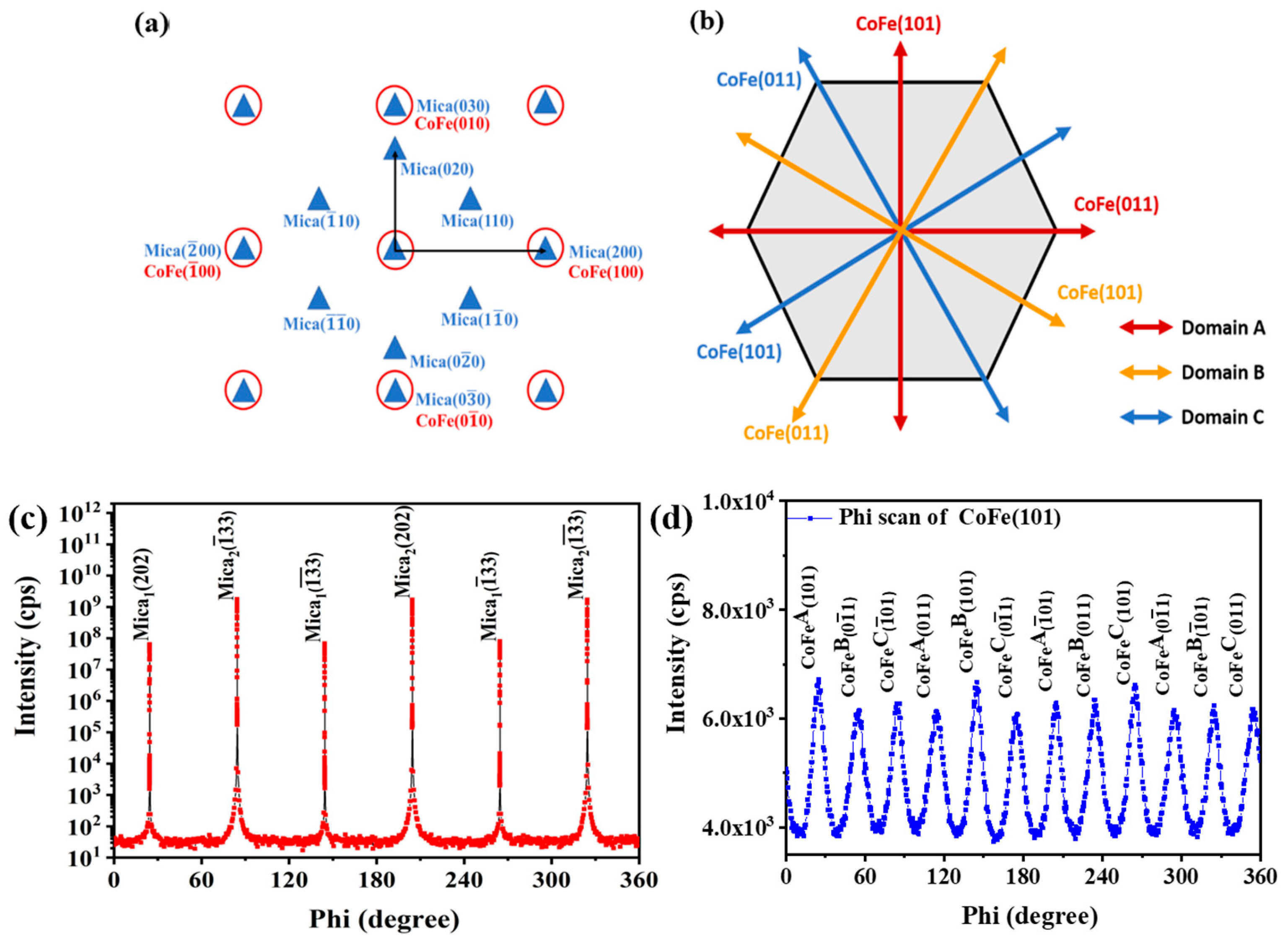
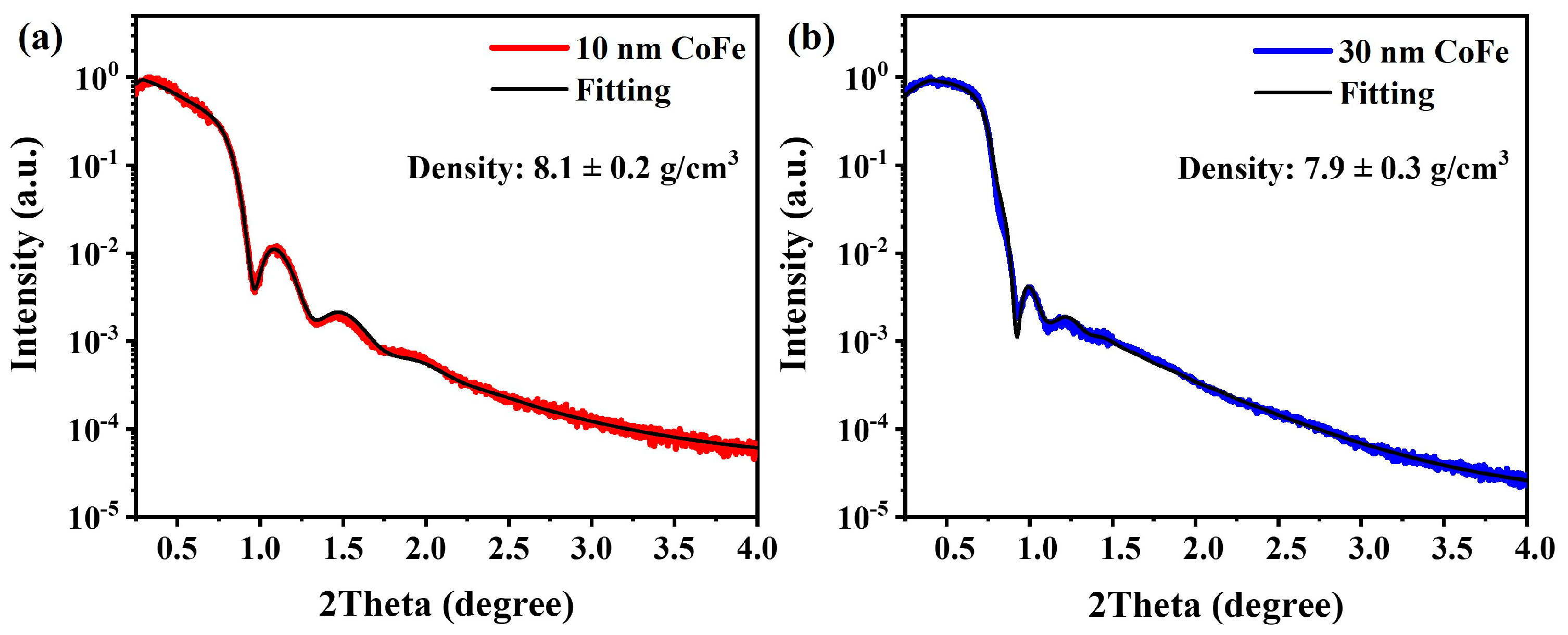
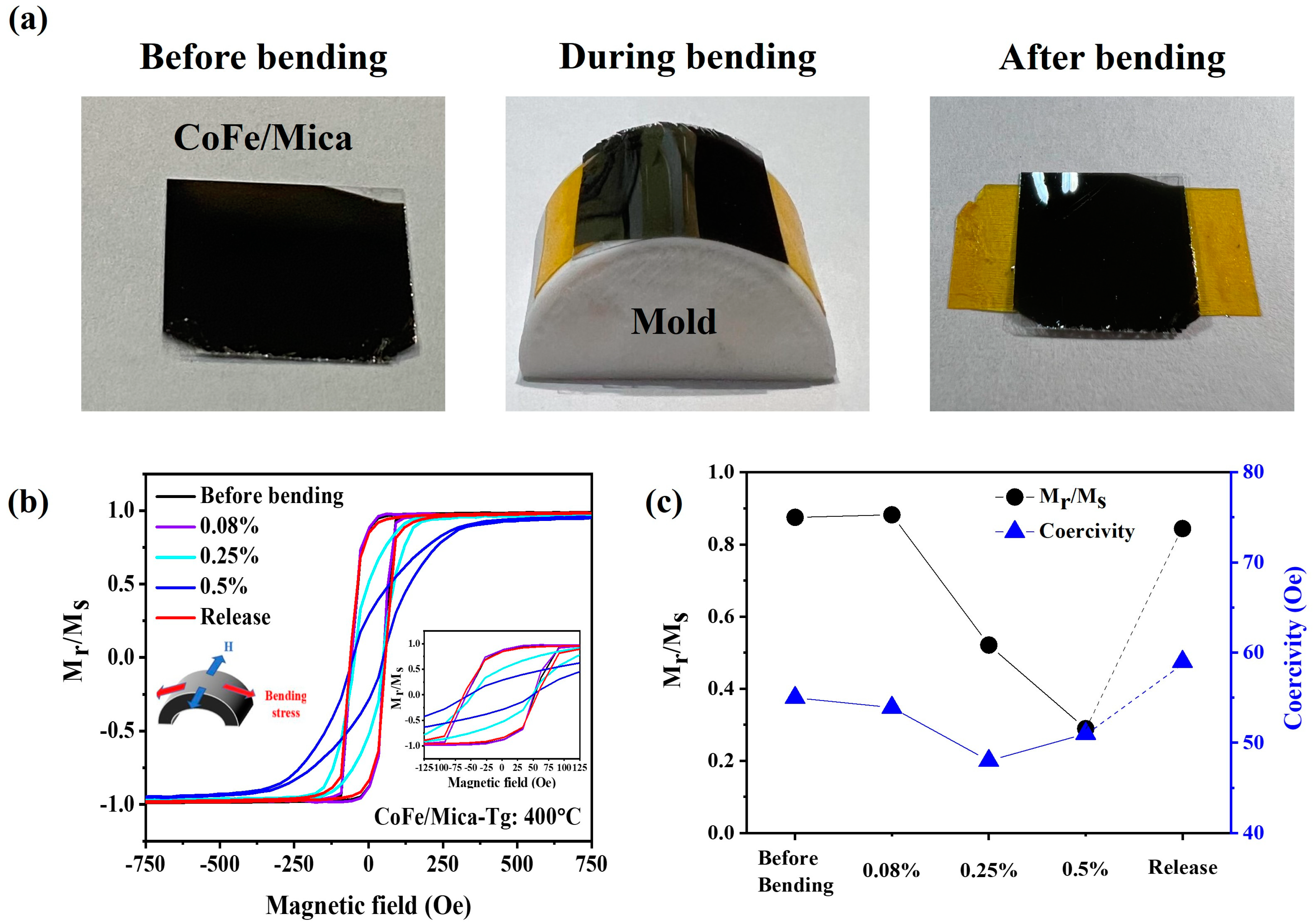
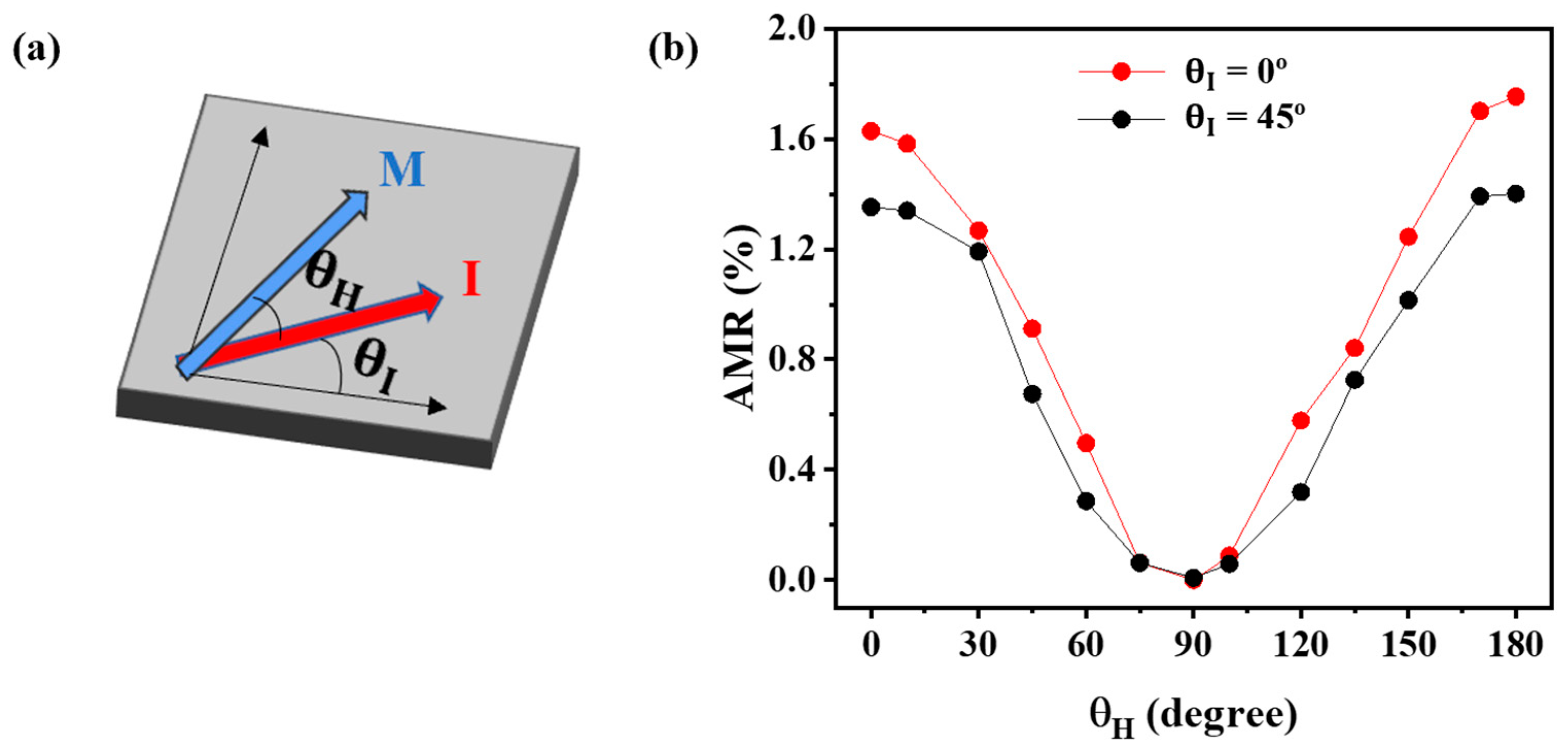
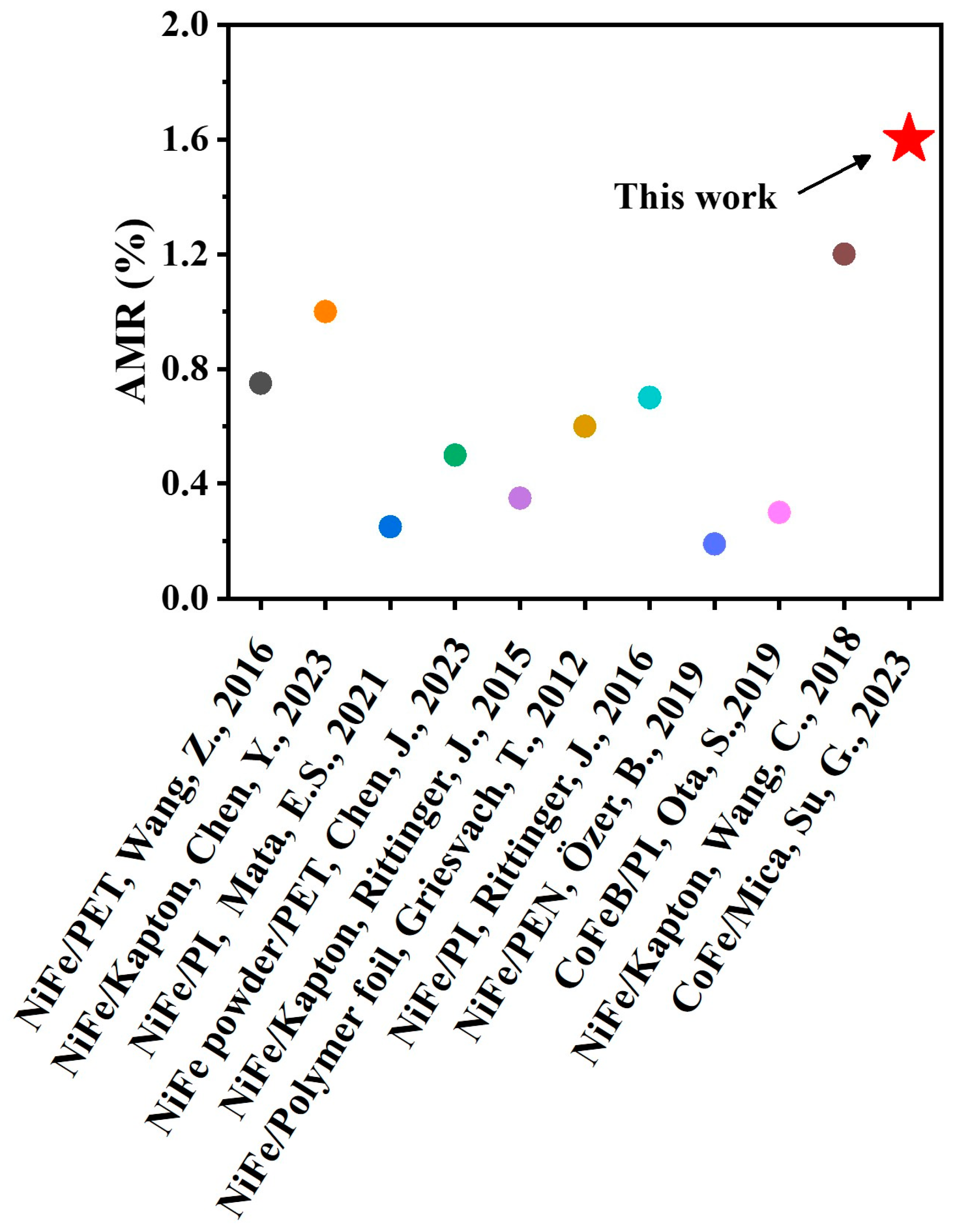
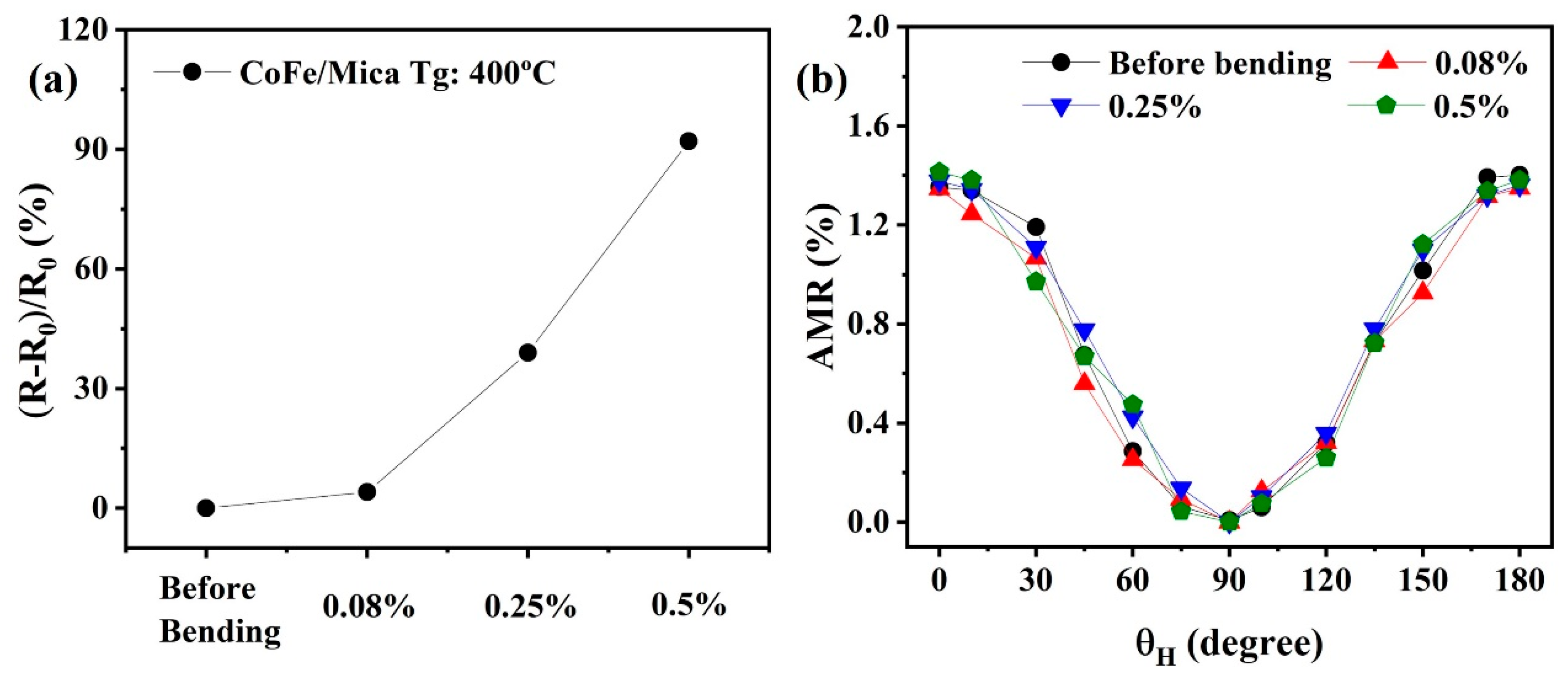

| Lattice Constant of CoFe | Sample Type | Reference |
|---|---|---|
| 2.855 Å (Experimental) | CoFe powder | [32] |
| 2.855 Å (Experimental) | CoFe powder | [33] |
| 2.857 Å (Experimental) | CoFe powder | [34] |
| 2.857 Å (Calculated) | Bulk CoFe | [35] |
| 2.858 Å (Experimental) | Thin film—CoFe/n-Si | [36] |
| 2.863 Å (Experimental) | Thin film—CoFe/p-Si | [37] |
| 2.870 Å (Experimental) | Thin film—CoFe/MgO | [38] |
| 2.855 Å (Experimental) | Thin film—CoFe/mica | This work |
| Material | Method of Preparation | Substrate Used | Thickness | AMR Ratio (%) | Ref. |
|---|---|---|---|---|---|
| Ni0.81Fe0.19 | DC magnetron sputtering | Polyethylene terephthalate | 30 nm | 0.75 | [20] |
| Ni0.81Fe0.19 | DC magnetron sputtering | Kapton | 10 nm | 1 | [21] |
| Ni0.81Fe0.19 | DC magnetron sputtering | Mylar foil | 100 nm | 0.25 | [22] |
| Ni0.80Fe0.20 | Ion beam sputtering | Polyimide | 60 nm | 0.5 | [43] |
| Ni0.81Fe0.19 | RF sputtering | Kapton | 100 nm | 0.34 | [44] |
| Ni0.81Fe0.19 | Sputtering | Polymer foil | 50 nm | 0.6 | [45] |
| Ni0.81Fe0.19 | RF sputtering | Polyimide | 100 nm | 0.7 | [46] |
| NiFe | Magnetron sputtering | Kapton | 10 nm | 0.19 | [47] |
| Co20Fe60B20 | Sputtering | Polyimide | 2.7 nm | 0.2 | [48] |
| NiFe | Sputtering | Kapton | NA | 1.2 | [49] |
| Co50Fe50 | DC magnetron sputtering | Mica | 50 nm | 1.6 | This work |
Disclaimer/Publisher’s Note: The statements, opinions and data contained in all publications are solely those of the individual author(s) and contributor(s) and not of MDPI and/or the editor(s). MDPI and/or the editor(s) disclaim responsibility for any injury to people or property resulting from any ideas, methods, instructions or products referred to in the content. |
© 2023 by the authors. Licensee MDPI, Basel, Switzerland. This article is an open access article distributed under the terms and conditions of the Creative Commons Attribution (CC BY) license (https://creativecommons.org/licenses/by/4.0/).
Share and Cite
Su, G.-Y.; You, M.-C.; Chuang, K.-W.; Wu, M.-H.; Hsieh, C.-H.; Lin, C.-Y.; Yang, C.-Y.; Anbalagan, A.k.; Lee, C.-H. Investigating Anisotropic Magnetoresistance in Epitaxially Strained CoFe Thin Films on a Flexible Mica. Nanomaterials 2023, 13, 3154. https://doi.org/10.3390/nano13243154
Su G-Y, You M-C, Chuang K-W, Wu M-H, Hsieh C-H, Lin C-Y, Yang C-Y, Anbalagan Ak, Lee C-H. Investigating Anisotropic Magnetoresistance in Epitaxially Strained CoFe Thin Films on a Flexible Mica. Nanomaterials. 2023; 13(24):3154. https://doi.org/10.3390/nano13243154
Chicago/Turabian StyleSu, Guang-Yang, Min-Chang You, Kai-Wei Chuang, Ming-Hsuan Wu, Cheng-Hsun Hsieh, Chun-Yen Lin, Chao-Yao Yang, Aswin kumar Anbalagan, and Chih-Hao Lee. 2023. "Investigating Anisotropic Magnetoresistance in Epitaxially Strained CoFe Thin Films on a Flexible Mica" Nanomaterials 13, no. 24: 3154. https://doi.org/10.3390/nano13243154
APA StyleSu, G.-Y., You, M.-C., Chuang, K.-W., Wu, M.-H., Hsieh, C.-H., Lin, C.-Y., Yang, C.-Y., Anbalagan, A. k., & Lee, C.-H. (2023). Investigating Anisotropic Magnetoresistance in Epitaxially Strained CoFe Thin Films on a Flexible Mica. Nanomaterials, 13(24), 3154. https://doi.org/10.3390/nano13243154








